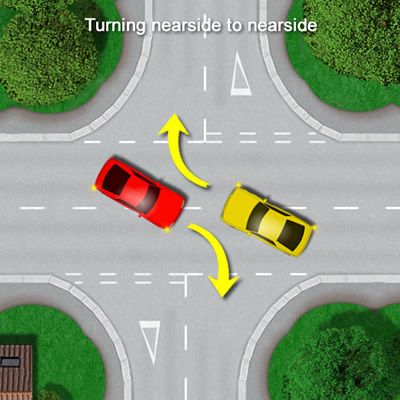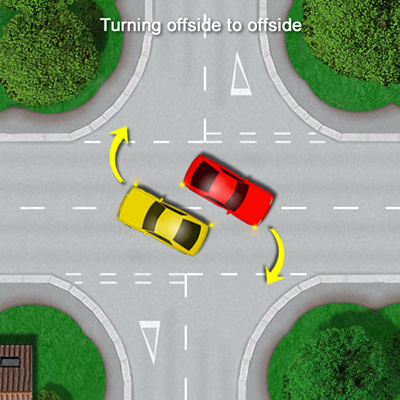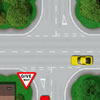You may have at some point recalled a car garage engineer referring to a vehicles component location as being nearside or offside.
So what does nearside and offside mean?
The nearside offside definition for cars is as follows:
Easily remembered by using the kerb. The passenger side of your vehicle is closest to the kerb whilst driving in the UK. So think of the side nearest the kerb – nearside and the drivers side – offside.
Other than the various nearside and offside vehicle components however, there are other situations when the nearside and offside phrase is used.
When turning right at a crossroads along with the vehicle on the opposite side of the crossroads turning to their right, a decision has to be made whether to turn nearside or offside.
Turning at crossroads
When two vehicles directly opposite are both turning right at a crossroads, there are two options on how to do this. Occasionally a crossroads may provide lanes and directional arrows to assist, but most don’t so it’s down to the drivers to sort it out. The two options available are:
- Nearside to nearside – where vehicles turn in front of each others passenger door to passenger door, or nearside to nearside.
- Offside to offside – where vehicles turn behind each other, driver door to driver door.

Turning nearside to nearside
By far the most common technique for turning right with another vehicle at a crossroads is nearside to nearside. Although this is technically the most unsafe technique due to the other vehicle turning blocking your view of the road ahead of oncoming vehicles, it is widely used.
Drivers tend to prefer to assess passing distances based on the front of their vehicle, making this technique the most frequently used. Ensure you stay on your side of the road until you can safely observe it is clear of oncoming vehicles before proceeding. Certain staggered junctions or crossroads make this technique inappropriate and the offside to offside technique the easier option.

Turning offside to offside
Technically turning using the offside to offside technique is the safest method as stated by the Highway Code. The reason being is that it allows for a clear view of any oncoming vehicles so to assess safely if it is safe to continue or give way.
The issue with this technique however is if there is more than one vehicle turning right from each side of the road, the second vehicle if waiting close behind the first vehicle, will prevent the vehicle on the opposite side of the road from turning as it will be blocking the way. The offside to offside technique is seldom used and if used frequently would cause significantly longer traffic queues on busy roads.
Nearside to nearside or offside to offside
If there are no road markings to assist, then it is a reasonable bet to assume that traffic will be using the nearside to nearside method. However, don’t assume this is the case without assessing the situation. Look at other vehicles turning on the crossroads to establish the technique they are using and follow accordingly. It’s not advised to use the alternative technique than other vehicles as this is likely to cause confusion.

Crossroads Junction
The offside to offside and nearside to nearside rule is often used whilst turning at crossroads. The crossroads tutorial offers a guide along with diagrams on how to best use these junction types safely for the practical driving test.

Offside to offside doesn’t cause traffic queues if the any following driver to also turn right only advances ahead when the first leaves , and it should be the only way to turn right in crossroads, especially when people don’t get the forwardest in the main lane just to turn right using nearside to nearside and , making everybody else behind (not turning ) having to wait for them to turn ( whenever that comes available, which in some cases can take minutes), apart from the danger of not seeing the incoming traffic from the back of the opposite driver turning, terrible
Thanks for great explanation. Please note that from experience, offside to offside positions tend to take up significantly more road space, because of the extra overpassing vehicle manoeuvre, it’s a limiting factor on UK roads. It’s only used where there are arrows indicating such an approach, typically a large intersection with rising steep curves to the junction which limit forward view, it’s safer to see ahead, but it’s an awkward manoeuvre getting round each other in confined intersections.
“So think of the side nearest the kerb – nearside and the drivers side – offside.” Eh? There couldn’t be a more obscure, muddling and muddled sentence!
So if you’re driving along a road (hopefully on the left), the side of your car nearest the kerb is the nearside (the left side) and the driver side is the offside (the right side of the car). ‘Near the kerb = nearside’. It’s often best to avoid ‘left’ or ‘right’ at the start as some learners get them confused.
Nearside = passengers side
Offside = drivers side
Think of it as being counter-intuitive since you would expect Nearside to be the side NEAREST the main driver, not the passenger.
The usage of offside and nearside should cease because it uses a reference point that is not part of the vehicle.
Curbs don’t exist everywhere and are not attached to the vehicle.
Hello Len,
I don’t there necessarily needs to be a physical kerb to know where it would normally be. On most town and city roads, there are kerbs.
In the real world (not in Highway Code world), offside to offside is just as dangerous as nearside to nearside because your view of the road ahead would be blocked by the second waiting car facing you.
Offside to offside is only safer when there is only 1 car waiting in each direction.
Nearside to nearside is better because the traffic flow is smoother, rather than each car turning one at a time.
The only time I would suggest using offside to offside is when the junction is staggered enough to dictate that it makes more sense to use offside to offside.
Near side and offside originated with horsemanship, the near side being the side you mount from.
Interesting to know, Bea 🙂